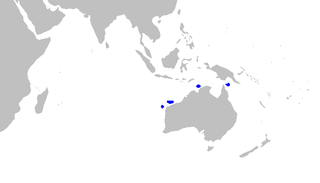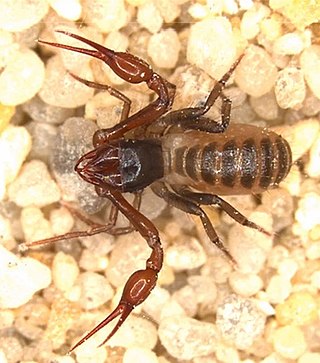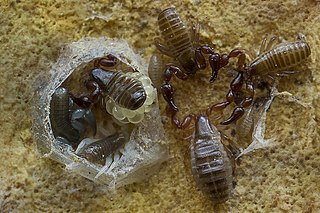
The slender sawtail catshark is a little-known species of catshark, part of the family Scyliorhinidae, endemic to northern Australia. It is found over the continental slope in 290–470 m (950–1,540 ft) on water. Growing to 34 cm (13 in) long, this shark has a slim gray body with four dark saddle markings below the dorsal fins and on the caudal fin, as well as a prominent crest of enlarged dermal denticles along the dorsal edge of the caudal fin. The slender sawtail catshark is not valued by fisheries but is taken as bycatch. The International Union for Conservation of Nature (IUCN) presently lacks enough information to assess its conservation status.

Paludirex is an extinct genus of mekosuchine crocodylian from the Pliocene and Pleistocene of Australia. A large and robust semi-aquatic ambush hunter capable of attaining lengths of up to 5 m (16 ft), it was likely the top predator of Australia's waterways prior to the appearance of modern saltwater crocodiles. Two species are known, the smaller Paludirex gracilis and the larger Paludirex vincenti. A third as of yet unnamed species may have also existed.

The Platycnemididae are a family of damselflies. They are known commonly as white-legged damselflies. There are over 400 species native to the Old World. The family is divided into several subfamilies.

Indolestes is a genus of damselflies in the family Lestidae. Species of Indolestes can be medium-sized, dull coloured dragonflies. They are found from India through Asia, Australia and the Pacific.

The New Zealand goose is a bird of the extinct genus Cnemiornis of the family Anatidae, subfamily Anserinae. The genus, endemic to New Zealand, consisted of two species: the North Island goose, C. gracilis and the South Island goose C. calcitrans.

Chernetidae is a family of pseudoscorpions, first described by Anton Menge in 1855.
Nesidiochernes is a genus of pseudoscorpions in the Chernetidae family. It was described in 1957 by Austrian arachnologist Max Beier.
Synsphyronus is a genus of pseudoscorpions in the Garypidae family. It was described in 1930 by American arachnologist Joseph Conrad Chamberlin. Its distribution is mainly in Australia, but also extends to New Zealand and New Caledonia.

Garypus is a genus of pseudoscorpions in the family Garypidae. It was described by German arachnologist Ludwig Carl Christian Koch in 1873. The species are found mainly in tropical and subtropical areas, where they occupy supralittoral and littoral zones in seashore habitats.

The Hierodulinae are a subfamily of praying mantids, originally used by Brunner von Wattenwyl. It was restored as part of a major revision of mantid taxonomy, and now contains genera previously placed elsewhere in the family Mantidae.

Lachnaea is a genus of flowering plants in the family Thymelaeaceae, found in the Cape Floristic Region of southern South Africa. They tend to be small ericoid shrubs.
Cordylochernes is a genus of pseudoscorpions in the Chernetidae family. It was described in 1932 by Austrian arachnologist Max Beier.
Irdex is a genus of earwigs belonging to the subfamily Spongiphorinae.
Austrochernes is a genus of pseudoscorpions in the subfamily Chernetinae, first described by Max Beier in 1932. Species of this genus are found in mainland Australia and New Guinea. The Australian Faunal Directory decisions for synonymy are based on a 2018 paper by Mark Harvey.

Pseudotyrannochthonius is a genus of pseudoscorpions in the family Pseudotyrannochthoniidae. It was described in 1930 by Austrian arachnologist Max Beier.
Dactylochelifer is a genus of pseudoscorpions in the family Cheliferidae, first described by Max Beier in 1932.

Paratemnoides is a genus of pseudoscorpions in the Atemnidae family. It was described in 1991 by Australian arachnologist Mark Harvey.
Haplochernes is a genus of pseudoscorpions in the Chernetidae family. It was described in 1932 by Austrian arachnologist Max Beier.
Sundochernes is a genus of pseudoscorpions in the Chernetidae family. It was described in 1932 by Austrian arachnologist Max Beier.










